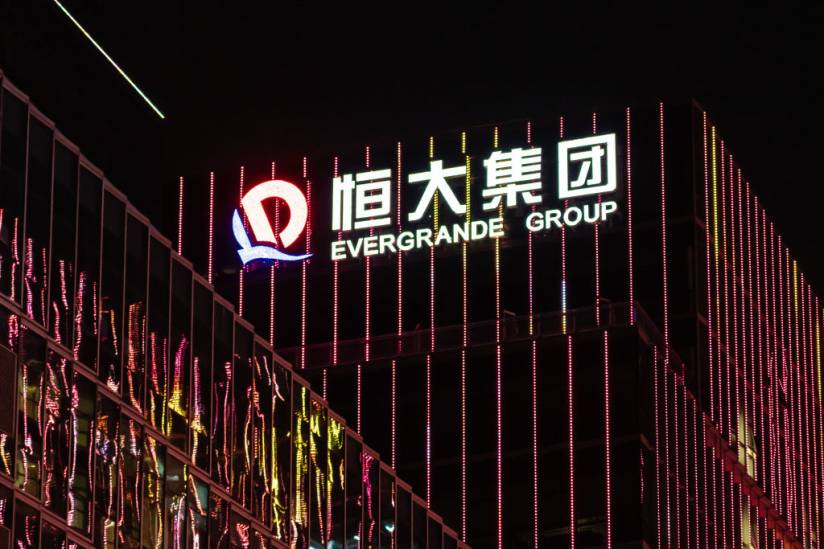What China Must Do to Contain Evergrande Fallout
Biggest risk to China is from Evergrande’s small creditors, not its large ones.
China’s second-largest real-estate developer by revenue—with liabilities equal to around 2% of the country’s gross domestic product—is in danger of going under. After weeks of ignoring Evergrande’s wobbles, on Monday Wall Street finally stood up and listened: the S&P 500 dropped 2% and global bond funds, some of them invested heavily in Chinese developers’ dollar debt, retreated. Evergrande must pay approx. $115 million in bond interest on Thursday, and is fending off protests and court cases from its domestic suppliers, customers and investors.
A default on dollar debt or at least a deep haircut is likely. Large-scale financial turmoil in China isn’t inevitable. If Evergrande’s woes further infect the broader real-estate market or Beijing doesn’t act quickly enough to restructure the company’s businesses and its onshore debts in an orderly manner, it may not be far behind.
In years past, such a large, important firm would almost certainly have been bailed out. Housing is the third rail of China’s political economy—where most household wealth is parked, a giant liability for China’s banks, and tied to around a fifth of economic activity. But President Xi Jinping has demonstrated a far higher tolerance for economic risk than his immediate predecessors, in part because he has cowed potential rivals so effectively. Evergrande’s woes are a direct result of a new, steely-eyed policy forcing developers to meet tough metrics on debt instituted last year.
As long as onshore financial contagion is manageable, Xi may allow some bondholders—particularly foreign ones—to be wiped out in service of larger policy goals. And so far, signs of that broader onshore contagion are limited. One reason: many of Evergrande’s large domestic creditors like banks are owned by the government, which can both force them to absorb immediate losses and also tide them over with liquidity while working to engineer eventual recapitalizations. Beijing has repeatedly demonstrated its capacity to corral debtors and big creditors and force them to come to an agreement behind the scenes, as in the case of Baoshang Bank’s 2019 crisis.
Evergrande’s offshore bonds are trading at deeply distressed levels. And yields on the dollar bonds of some other large, highly indebted developers like Sunac have shot higher, too: Sunac’s June 2022 issue, which was trading at a 6% yield in early September, now yields 17%, according to FactSet. But, although onshore money-market rates have risen modestly, there are few signs of contagion to key bank funding instruments or to the onshore bond market more broadly outside of real estate.
The real problem isn’t Evergrande’s big creditors but the small ones and the damage to already-weak real-estate sentiment more broadly from an extended, messy reorganisation. That could quickly translate into broader problems for the industry as a whole, the real economy and banks.
Evergrande has massive borrowings but it also owed, as of June, around US$180 billion to individual homeowners, its contractors and others in the form of outstanding accounts payable and so-called contract liabilities—mostly unbuilt homes owed to buyers. More than half of its projects nationwide have been halted, according to local financial media outlet Caixin. And this comes as nationwide housing sales are already down 20% year over year by value in August.
The last thing China’s real-estate market and its financial system need is a buyers’ strike from homeowners watching Evergrande customers get stiffed. To hit new regulatory targets by mid 2023, Chinese developers in aggregate need to shed 18 trillion yuan ($2.78 trillion) of liabilities over the next two years, according to Goldman Sachs. And that assumes no further land purchases over that time period. Robust housing sales will be needed, but unless Beijing acts swiftly to ensure that Evergrande’s customers get their due, arresting the steep drop in national housing sales may prove difficult.
The simplest solution would be a government-mediated takeover of Evergrande’s unfinished projects by a group of other developers in exchange for Evergrande’s existing inventory and massive land bank, lubricated with additional state finance. But with the land market already frozen up—transactions by value were down 90% in the first 12 days of September year over year, according to Nomura—developers are presumably dragging their feet. If the situation drags on and Evergrande has to keep pawning off its existing properties at fire-sale rates, that could also be a further drag on the property market as a whole, given how large the company is. Evergrande alone accounted for around 4% of the residential property market in 2020, according to Fitch Ratings.
The land market itself is another possible route for financial contagion, since land sales form such an important part of local government revenue in China. So-called local government financing vehicle (LGFV) bonds, used by local governments to get around formal budget constraints, account for a significant proportion of the market: around 30% of total outstanding onshore bond debt, after excluding formal government and policy bank bonds, according to Wind.
Clearly much depends on how quickly Beijing is able to assemble a coalition of developers to assume Evergrande’s contract liabilities or find another solution to avoid a disorderly sale of its assets and a big financial hit to its customers and suppliers.
If a solution does appear soon and Beijing acts to further ease overall monetary policy, there are some reasons for cautious optimism that China can still avoid a truly punishing property downturn. Prices in major coastal markets were still mostly rising in August, although many smaller so-called third- and fourth-tier markets are beginning to turn down. And property inventories nationwide are much lower, on average, than at the beginning of the last major housing downturn in 2015, which could help put a floor under prices if sentiment itself recovers a bit: one-and-a-half years of sales, according to ANZ Bank, against two-and-a-half years in 2015. Finally, although Chinese banks have large mortgage exposure, unlike in the U.S. Chinese mortgages are generally “full recourse,” meaning debtors remain on the hook for payments even after losing their home. That may help keep delinquencies in check, even if prices do fall sharply.
A significant hit to growth in late 2021 and early 2022 does seem unavoidable now, but if Beijing acts decisively it could still avoid something worse. The next few weeks—usually the frothiest season in China’s real-estate market—will be crucial.
 Copyright 2020, Dow Jones & Company, Inc. All Rights Reserved Worldwide. LEARN MORE
Copyright 2020, Dow Jones & Company, Inc. All Rights Reserved Worldwide. LEARN MORE
This stylish family home combines a classic palette and finishes with a flexible floorplan
Just 55 minutes from Sydney, make this your creative getaway located in the majestic Hawkesbury region.
Ahead of the Games, a breakdown of the city’s most desirable places to live
PARIS —Paris has long been a byword for luxurious living. The traditional components of the upscale home, from parquet floors to elaborate moldings, have their origins here. Yet settling down in just the right address in this low-rise, high-density city may be the greatest luxury of all.
Tradition reigns supreme in Paris real estate, where certain conditions seem set in stone—the western half of the city, on either side of the Seine, has long been more expensive than the east. But in the fashion world’s capital, parts of the housing market are also subject to shifting fads. In the trendy, hilly northeast, a roving cool factor can send prices in this year’s hip neighborhood rising, while last year’s might seem like a sudden bargain.
This week, with the opening of the Olympic Games and the eyes of the world turned toward Paris, The Wall Street Journal looks at the most expensive and desirable areas in the City of Light.
The Most Expensive Arrondissement: the 6th
Known for historic architecture, elegant apartment houses and bohemian street cred, the 6th Arrondissement is Paris’s answer to Manhattan’s West Village. Like its New York counterpart, the 6th’s starving-artist days are long behind it. But the charm that first wooed notable residents like Gertrude Stein and Jean-Paul Sartre is still largely intact, attracting high-minded tourists and deep-pocketed homeowners who can afford its once-edgy, now serene atmosphere.
Le Breton George V Notaires, a Paris notary with an international clientele, says the 6th consistently holds the title of most expensive arrondissement among Paris’s 20 administrative districts, and 2023 was no exception. Last year, average home prices reached $1,428 a square foot—almost 30% higher than the Paris average of $1,100 a square foot.
According to Meilleurs Agents, the Paris real estate appraisal company, the 6th is also home to three of the city’s five most expensive streets. Rue de Furstemberg, a secluded loop between Boulevard Saint-Germain and the Seine, comes in on top, with average prices of $2,454 a square foot as of March 2024.
For more than two decades, Kyle Branum, a 51-year-old attorney, and Kimberly Branum, a 60-year-old retired CEO, have been regular visitors to Paris, opting for apartment rentals and ultimately an ownership interest in an apartment in the city’s 7th Arrondissement, a sedate Left Bank district known for its discreet atmosphere and plutocratic residents.
“The 7th was the only place we stayed,” says Kimberly, “but we spent most of our time in the 6th.”
In 2022, inspired by the strength of the dollar, the Branums decided to fulfil a longstanding dream of buying in Paris. Working with Paris Property Group, they opted for a 1,465-square-foot, three-bedroom in a building dating to the 17th century on a side street in the 6th Arrondissement. They paid $2.7 million for the unit and then spent just over $1 million on the renovation, working with Franco-American visual artist Monte Laster, who also does interiors.
The couple, who live in Santa Barbara, Calif., plan to spend about three months a year in Paris, hosting children and grandchildren, and cooking after forays to local food markets. Their new kitchen, which includes a French stove from luxury appliance brand Lacanche, is Kimberly’s favourite room, she says.
Another American, investor Ashley Maddox, 49, is also considering relocating.
In 2012, the longtime Paris resident bought a dingy, overstuffed 1,765-square-foot apartment in the 6th and started from scratch. She paid $2.5 million and undertook a gut renovation and building improvements for about $800,000. A centrepiece of the home now is the one-time salon, which was turned into an open-plan kitchen and dining area where Maddox and her three children tend to hang out, American-style. Just outside her door are some of the city’s best-known bakeries and cheesemongers, and she is a short walk from the Jardin du Luxembourg, the Left Bank’s premier green space.
“A lot of the majesty of the city is accessible from here,” she says. “It’s so central, it’s bananas.” Now that two of her children are going away to school, she has listed the four-bedroom apartment with Varenne for $5 million.
The Most Expensive Neighbourhoods: Notre-Dame and Invalides
Garrow Kedigian is moving up in the world of Parisian real estate by heading south of the Seine.
During the pandemic, the Canada-born, New York-based interior designer reassessed his life, he says, and decided “I’m not going to wait any longer to have a pied-à-terre in Paris.”
He originally selected a 1,130-square-foot one-bedroom in the trendy 9th Arrondissement, an up-and-coming Right Bank district just below Montmartre. But he soon realised it was too small for his extended stays, not to mention hosting guests from out of town.
After paying about $1.6 million in 2022 and then investing about $55,000 in new decor, he put the unit up for sale in early 2024 and went house-shopping a second time. He ended up in the Invalides quarter of the 7th Arrondissement in the shadow of one Paris’s signature monuments, the golden-domed Hôtel des Invalides, which dates to the 17th century and is fronted by a grand esplanade.
His new neighbourhood vies for Paris’s most expensive with the Notre-Dame quarter in the 4th Arrondissement, centred on a few islands in the Seine behind its namesake cathedral. According to Le Breton, home prices in the Notre-Dame neighbourhood were $1,818 a square foot in 2023, followed by $1,568 a square foot in Invalides.
After breaking even on his Right Bank one-bedroom, Kedigian paid $2.4 million for his new 1,450-square-foot two-bedroom in a late 19th-century building. It has southern exposures, rounded living-room windows and “gorgeous floors,” he says. Kedigian, who bought the new flat through Junot Fine Properties/Knight Frank, plans to spend up to $435,000 on a renovation that will involve restoring the original 12-foot ceiling height in many of the rooms, as well as rescuing the ceilings’ elaborate stucco detailing. He expects to finish in 2025.
Over in the Notre-Dame neighbourhood, Belles demeures de France/Christie’s recently sold a 2,370-square-foot, four-bedroom home for close to the asking price of about $8.6 million, or about $3,630 a square foot. Listing agent Marie-Hélène Lundgreen says this places the unit near the very top of Paris luxury real estate, where prime homes typically sell between $2,530 and $4,040 a square foot.
The Most Expensive Suburb: Neuilly-sur-Seine
The Boulevard Périphérique, the 22-mile ring road that surrounds Paris and its 20 arrondissements, was once a line in the sand for Parisians, who regarded the French capital’s numerous suburbs as something to drive through on their way to and from vacation. The past few decades have seen waves of gentrification beyond the city’s borders, upgrading humble or industrial districts to the north and east into prime residential areas. And it has turned Neuilly-sur-Seine, just northwest of the city, into a luxury compound of first resort.
In 2023, Neuilly’s average home price of $1,092 a square foot made the leafy, stately community Paris’s most expensive suburb.
Longtime residents, Alain and Michèle Bigio, decided this year is the right time to list their 7,730-square-foot, four-bedroom townhouse on a gated Neuilly street.
The couple, now in their mid 70s, completed the home in 1990, two years after they purchased a small parcel of garden from the owners next door for an undisclosed amount. Having relocated from a white-marble château outside Paris, the couple echoed their previous home by using white- and cream-coloured stone in the new four-story build. The Bigios, who will relocate just back over the border in the 16th Arrondissement, have listed the property with Emile Garcin Propriétés for $14.7 million.
The couple raised two adult children here and undertook upgrades in their empty-nester years—most recently, an indoor pool in the basement and a new elevator.
The cool, pale interiors give way to dark and sardonic images in the former staff’s quarters in the basement where Alain works on his hobby—surreal and satirical paintings, whose risqué content means that his wife prefers they stay downstairs. “I’m not a painter,” he says. “But I paint.”
The Trendiest Arrondissement: the 9th
French interior designer Julie Hamon is theatre royalty. Her grandfather was playwright Jean Anouilh, a giant of 20th-century French literature, and her sister is actress Gwendoline Hamon. The 52-year-old, who divides her time between Paris and the U.K., still remembers when the city’s 9th Arrondissement, where she and her husband bought their 1,885-square-foot duplex in 2017, was a place to have fun rather than put down roots. Now, the 9th is the place to do both.
The 9th, a largely 19th-century district, is Paris at its most urban. But what it lacks in parks and other green spaces, it makes up with nightlife and a bustling street life. Among Paris’s gentrifying districts, which have been transformed since 2000 from near-slums to the brink of luxury, the 9th has emerged as the clear winner. According to Le Breton, average 2023 home prices here were $1,062 a square foot, while its nearest competitors for the cool crown, the 10th and the 11th, have yet to break $1,011 a square foot.
A co-principal in the Bobo Design Studio, Hamon—whose gut renovation includes a dramatic skylight, a home cinema and air conditioning—still seems surprised at how far her arrondissement has come. “The 9th used to be well known for all the theatres, nightclubs and strip clubs,” she says. “But it was never a place where you wanted to live—now it’s the place to be.”
With their youngest child about to go to college, she and her husband, 52-year-old entrepreneur Guillaume Clignet, decided to list their Paris home for $3.45 million and live in London full-time. Propriétés Parisiennes/Sotheby’s is handling the listing, which has just gone into contract after about six months on the market.
The 9th’s music venues were a draw for 44-year-old American musician and piano dealer, Ronen Segev, who divides his time between Miami and a 1,725-square-foot, two-bedroom in the lower reaches of the arrondissement. Aided by Paris Property Group, Segev purchased the apartment at auction during the pandemic, sight unseen, for $1.69 million. He spent $270,000 on a renovation, knocking down a wall to make a larger salon suitable for home concerts.
During the Olympics, Segev is renting out the space for about $22,850 a week to attendees of the Games. Otherwise, he prefers longer-term sublets to visiting musicians for $32,700 a month.
Most Exclusive Address: Avenue Junot
Hidden in the hilly expanses of the 18th Arrondissement lies a legendary street that, for those in the know, is the city’s most exclusive address. Avenue Junot, a bucolic tree-lined lane, is a fairy-tale version of the city, separate from the gritty bustle that surrounds it.
Homes here rarely come up for sale, and, when they do, they tend to be off-market, or sold before they can be listed. Martine Kuperfis—whose Paris-based Junot Group real-estate company is named for the street—says the most expensive units here are penthouses with views over the whole of the city.
In 2021, her agency sold a 3,230-square-foot triplex apartment, with a 1,400-square-foot terrace, for $8.5 million. At about $2,630 a square foot, that is three times the current average price in the whole of the 18th.
Among its current Junot listings is a 1930s 1,220-square-foot townhouse on the avenue’s cobblestone extension, with an asking price of $2.8 million.
This stylish family home combines a classic palette and finishes with a flexible floorplan
Just 55 minutes from Sydney, make this your creative getaway located in the majestic Hawkesbury region.






















